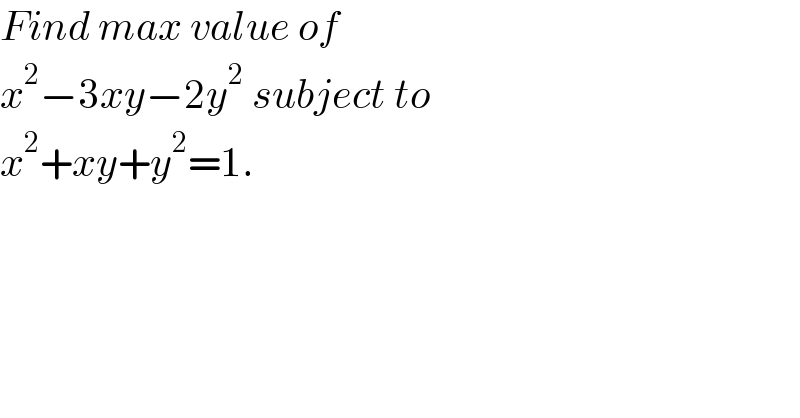
Question and Answers Forum
Question Number 138851 by bramlexs22 last updated on 19/Apr/21

Answered by ajfour last updated on 19/Apr/21
![F=x^2 −3xy−2y^2 F=x^2 +3x^2 +3y^2 −3−2y^2 F=4x^2 +y^2 −3 y=−(x/2)±(√((x^2 /4)+1−x^2 )) y=−(x/2)±(√(1−((3x^2 )/4))) F=4x^2 −2−x^2 +(x^2 /2)∓x(√(1−((3x^2 )/4))) F=((7x^2 )/2)−2∓x(√(1−((3x^2 )/4))) (dF/dx)=7x∓{(√(1−((3x^2 )/4)))−((3x^2 )/(4(√(1−((3x^2 )/4)))))}=0 ⇒ 49x^2 =1−((3x^2 )/4)+((9x^4 )/(16−12x^2 ))−((3x^2 )/2) ⇒ ((205x^2 )/4)=1+((9x^4 )/(16−12x^2 )) say x^2 =t ⇒ 205x^2 (4−3x^2 )=16−12x^2 +9x^4 ⇒ 624x^4 −832x^2 +16=0 ⇒ 39x^4 −52x^2 +1=0 x^2 =(2/3)±(√((4/9)−(1/(39)))) x^2 =(2/3)±(7/(3(√(13)))) but x^2 <(4/3) now compare F=((7x^2 )/2)−2+(√(x^2 −((3x^4 )/4))) for x^2 =0, (4/3), (2/3)±(7/(3(√(13)))) F(x^2 =0)=−2 F(x^2 =(4/3))=(8/3)≈2.6667 F(x^2 =(2/3)+(7/(3(√(13)))))≈ 2.737 F(x^2 =(2/3)−(7/(3(√(13)))))≈ −1.793 ⇒ F_(max) =F(x^2 =(2/3)+(7/(3(√(13))))) = (7/2)(((26+7(√(13)))/(39)))+{(((26+7(√(13)))/(39)))[1−(3/4)(((26+7(√(13)))/(39)))]}^(1/2) ≈ 2.737](Q138865.png)
Commented by ajfour last updated on 19/Apr/21

Answered by mr W last updated on 19/Apr/21

Commented by mr W last updated on 19/Apr/21

Commented by mr W last updated on 19/Apr/21

Answered by ajfour last updated on 19/Apr/21

Commented by ajfour last updated on 19/Apr/21

Commented by mr W last updated on 20/Apr/21

